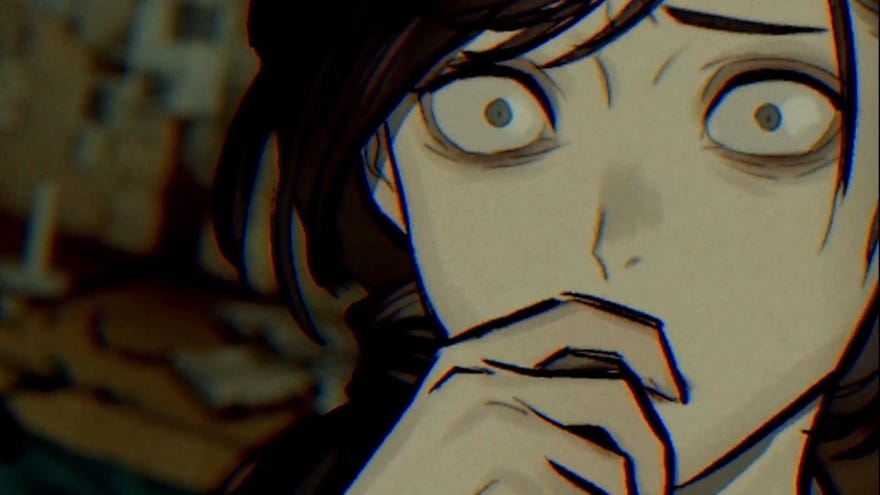Paranormasight's director says making a visual novel is always "messy work"
Takaya Ishiyama is pleased to see his game is going down well outside Japan
Paranormasight: The Seven Mysteries Of Honjo isn’t your average visual novel. There are some buck wild concepts in Square Enix’s game, including fourth wall breaks to manipulate characters' actions and literally muting someone by turning voices off in the options menu, to name just two of the wackier features (and a big plot twist is discussed in this article, so beware if you're planning on playing Paranormasight soon).
At the outset, though, Paranormasight loks like it is your average visual novel, with the player working away to prevent curses from claiming the lives of Tokyo citizens. Writer and director Takaya Ishiyama explains this was actually the starting point for Paranormasight’s inception. “I first decided what the final goal of the game would be, and from there I began to plot out the broad elements I needed to include, such as the Seven Mysteries,” he explains.
Paranormasight is divided up into five ‘routes’, with a different character spearheading each path and providing a different viewpoint on the events around Tokyo, as characters work to reclaim deadly curse stones and prevent murders. Aligning the five plot paths was a process of trial and error for Ishiyama, as the stories would at times become “misaligned” from their end goal, requiring he go back and smooth things out. “I always start out thinking I’m going to create a beautifully organised plot, but it never goes that way,” Ishiyama says. “It always ends up being messy work, trying to make each and every scene connect in a way that’s interesting.” With a handful of lead characters and a wide supporting cast to pace throughout Paranormasight, it’s a minor miracle the game’s plot unfolds so smoothly.
Another subversive element is Paranormasight letting the player explore 360 degrees around them. Visual novels typically plonk the player in front of a static 2D image, and though you might peruse that image at your will, you won’t be able to look behind you, or stretch your vision to see if there are any curses standing next to you (because that sure is a thing in Paranormasight). After putting together a team at Square Enix, Ishiyama knew he wanted to include a “new and unique kind of control scheme and visual style.” The concept of 360 degree visuals was snapped up by Ishiyama when presented to him, mainly because it “seemed like it could be an interesting format for players to enjoy”, but also because it “makes the storytelling for the Seven Mysteries of Honjo so distinctive” throughout Paranormasight.
_a4Cr5Bs.jpg?width=690&quality=80&format=jpg&auto=webp)
_ztdw6KB.jpg?width=690&quality=80&format=jpg&auto=webp)
The feature also helped give Paranormasight a sense of “realism”, Ishiyama reckons. Allowing the player to look all around them gives Paranormasight what he calls a “unique visual style", one that was achieved by processing multiple photos of locations together to create a one huge panorama of an area. I guess it’s a bit like those iPhone photos that let people scan their surroundings from one position to make a staggeringly wide panorama photo featuring a dog with a weirdly long body, except here the final result looks cracking.
But it's the fourth wall breaking that is arguably Paranormasight’s most shocking factor. In one instance you have to save the game to reassure another character you’ll remember a deceased former friend, and, as I already mentioned, another scene requires the player to completely turn off the game’s voice volume in the menu, to stop a curse reaching a character through its deadly voice. Ishiyama actually thinks there’s a “lot of games these days” that break the fourth wall by including “metafiction”, and the director wanted to subvert that in Paranormasight. It turns out gambits like remembering Michiyo via the save feature were intentional metafictional red herrings, made to make the player think they’re playing a metafiction piece that breaks the fourth wall and connects with them directly.
.jpg?width=690&quality=80&format=jpg&auto=webp)
This is all usurped by the grand reveal that the player isn't affecting the story themselves, but role-playing an established character who has a part in Paranormasight’s overarching plot. It’s an equally fascinating and brain-melting reveal, and one that honestly takes a long time to process. I admittedly thought I was playing an active role in Paranormasight’s story for the vast majority of the game, so Ishiyama got me fair and square with the twist.
Apart from all of that, Paranormasight is a surprising milestone for Ishiyama - it’s his first game to receive a Western localisation. Ishiyama might’ve been at Square Enix since 2005, working on Final Fantasy 12: Revenant Wing and Blood Of Bahamut among other projects, but Paranormasight marks his first ever English language release. That’s the director’s main impression from Paranormasight’s public reception - that a game of his has finally been “well-received outside of Japan”. “I’m really grateful to everyone who worked on the localisation for doing such wonderful work,” Ishiyama says, and also adds that Square Enix is “very pleased” with how Paranormasight has sold so far. It seems this brilliant, subversive visual novel has found the audience it deserves around the world.













